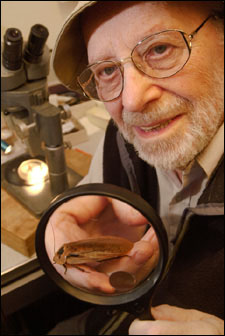Louis Roth:
Entomologist

“I just keep these for old times’ sake,” says entomologist Louis Roth, pulling a box from the shelf above his desk in a small office in the Museum of Comparative Zoology (MCZ).
Roth’s keepsakes aren’t photos or souvenirs. They’re cockroaches, perhaps a hundred shiny insects clambering over a banana peel.
“I collected these in the Amazon on a Harvard expedition in 1967,” he says proudly of the cockroach Schultesia, which he named for late Harvard botanist Richard Schultes, the Edward C. Jeffrey Professor of Biology Emeritus.
He opens another box, of Malagasy monsters the size of small mice. “Do you hear them hissing? They hiss in defense and they hiss when they copulate or when they court.”
Roth, considered the world’s leading authority on cockroaches (“If that’s true, it’s only because my competitors are all dead,” he demurs), has worked on a worldwide taxonomy of cockroaches at the MCZ since 1982. He has described and named 20 new genera and more than 400 species of cockroaches. Edward O. Wilson, Pellegrino University Research Professor Emeritus, invited him to continue his work at Harvard after he retired from the U.S. Army’s entomology laboratory in Natick in 1977.
Interested in insects since his childhood in Brooklyn, N.Y., Roth started his career with another winged nuisance, the mosquito, whose sexual behavior he studied until research on mosquitoes moved from the Army’s jurisdiction to that of the Surgeon General.
“So I looked around and I decided that cockroaches were an easy insect to rear and it was an important problem for the military,” he says.
It turns out that military cockroach problems are the same as civilian ones: infestation, particularly of species brought from other regions of the world, a potential for disease transmission, and even allergy and asthma. While Roth shows no squeamishness with the pests – he handles them casually, plucking one off his shirt when it leaps there – he admits that their reputation is not entirely undeserved.
There are about 5,000 species of cockroach worldwide, most of them in the tropics, but it’s the prominent German and American cockroaches that give the insect a bad name in the United States.
“The German cockroach is the worst,” Roth says. “It’s very cosmopolitan and usually infests heavily.”
At 84, Roth maintains a remarkable work ethic, arriving at the MCZ between 5 and 6 each morning (to beat the traffic from his home in Sherborn, he says) and working until just past noon, seven days a week.
“My wife, Edna, wants me to stay home on Sundays, but I’m a potato head when I stay home,” he says. “This is something I have to do before I forget it.”




